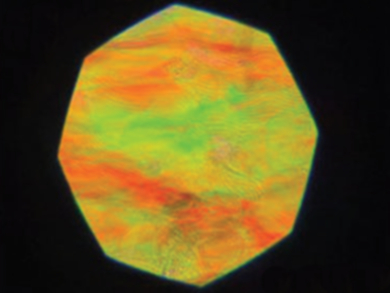Cellulose nanocrystals (CNCs) can be made by sulphuric acid hydrolysis of cellulose, a naturally abundant and sustainable biopolymer. The acid treatment introduces sulphate groups on the surface of the CNCs, which leads to the formation of a chiral nematic liquid crystalline phase in aqueous suspensions. This chiral nematic phase is preserved when the liquid is evaporated, giving rise to films with structural color. Unfortunately, the obtained materials are very brittle.
Silvia Vignolini, Cambridge University, UK, Wadood Hamad, FPInnovations, Vancouver, Canada, and colleagues have resolved these mechanical issues and prepared highly flexible and strong CNC films with iridescent colours (pictured). The team mixed the zwitterionic compound 3-(N,N-Dimethylmyristylammonio)propanesulfonate (DMAPS) with CNC suspensions at variable ratios and added either Na+ or H+ as the counterion.
DMAPS was found to electrostatically connect neighboring CNCs without affecting the chiral nematic order. When the ratio of DMAPS to CNC was increased, a red-shift of the reflected color was observed in the dried films. Materials with equal ratio of CNC to DMAPS and Na+ as the counterion showed remarkably high tensile strength and viscoelastic properties. According to the researchers, this system is viable for spray-coating onto a variety of surfaces, making it interesting for many industrial applications.
- Flexible Photonic Cellulose Nanocrystal Films,
Giulia Guidetti, Siham Atifi, Silvia Vignolini, Wadood Y. Hamad,
Adv. Mater. 2016.
DOI: 10.1002/adma.201603386


![Synthesis of [c2]Daisy Chains via Mechanochemistry](https://www.chemistryviews.org/wp-content/uploads/2025/04/202504_RotaxanesWithSolidStateMechanochemistry-125x94.png)

